Detailed Report on Occupational Health and Safety in the Workplace
VerifiedAdded on 2022/10/19
|5
|963
|496
Report
AI Summary
This report provides an overview of the Occupational Health and Safety (OHS) Act in Alberta, emphasizing the roles and responsibilities of both employers and employees in maintaining a safe work environment. The report outlines the purpose of the act, which includes promoting worker well-being, hazard awareness, and accident prevention. It details the employer's obligations, such as providing safety information, equipment, and training, as well as the employee's responsibilities, including reporting hazards and adhering to safety protocols. The report also covers the procedures for reporting and investigating workplace accidents, including the steps to be taken immediately after an incident, the investigation process, and the compensation for injured employees. The report further distinguishes between direct and indirect costs associated with workplace accidents, highlighting the financial implications of safety breaches and the importance of proactive safety measures.
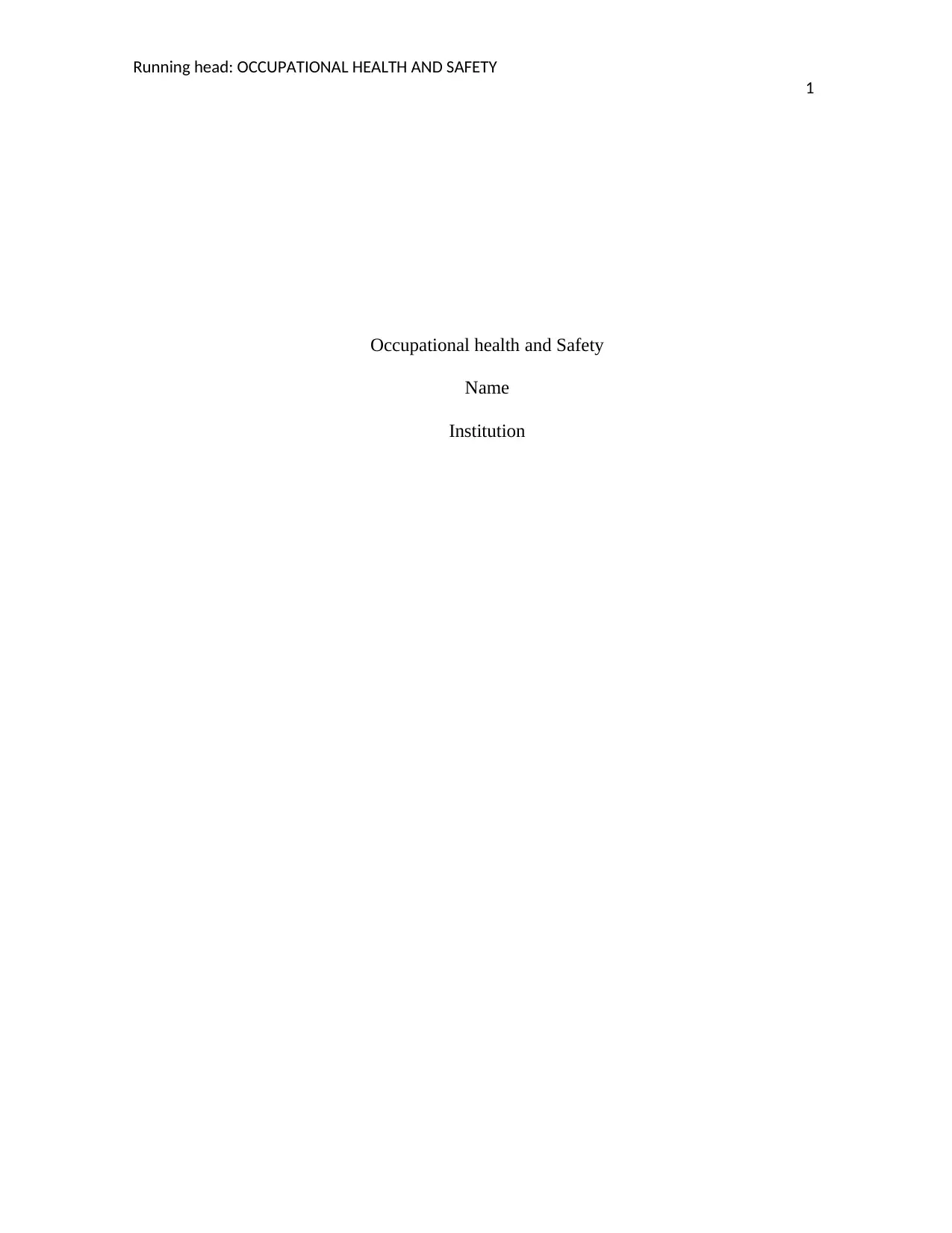
Running head: OCCUPATIONAL HEALTH AND SAFETY
1
Occupational health and Safety
Name
Institution
1
Occupational health and Safety
Name
Institution
Paraphrase This Document
Need a fresh take? Get an instant paraphrase of this document with our AI Paraphraser
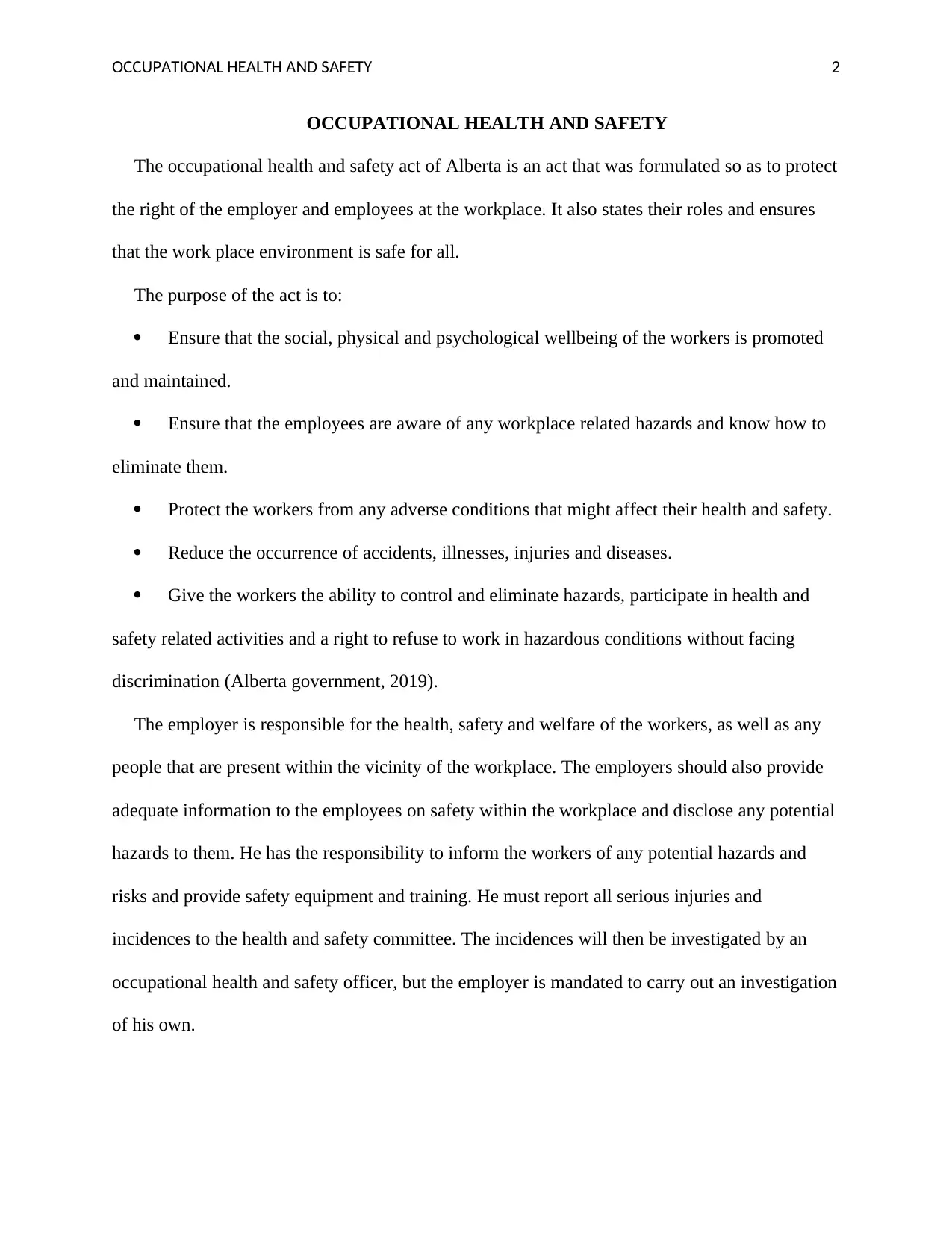
OCCUPATIONAL HEALTH AND SAFETY 2
OCCUPATIONAL HEALTH AND SAFETY
The occupational health and safety act of Alberta is an act that was formulated so as to protect
the right of the employer and employees at the workplace. It also states their roles and ensures
that the work place environment is safe for all.
The purpose of the act is to:
Ensure that the social, physical and psychological wellbeing of the workers is promoted
and maintained.
Ensure that the employees are aware of any workplace related hazards and know how to
eliminate them.
Protect the workers from any adverse conditions that might affect their health and safety.
Reduce the occurrence of accidents, illnesses, injuries and diseases.
Give the workers the ability to control and eliminate hazards, participate in health and
safety related activities and a right to refuse to work in hazardous conditions without facing
discrimination (Alberta government, 2019).
The employer is responsible for the health, safety and welfare of the workers, as well as any
people that are present within the vicinity of the workplace. The employers should also provide
adequate information to the employees on safety within the workplace and disclose any potential
hazards to them. He has the responsibility to inform the workers of any potential hazards and
risks and provide safety equipment and training. He must report all serious injuries and
incidences to the health and safety committee. The incidences will then be investigated by an
occupational health and safety officer, but the employer is mandated to carry out an investigation
of his own.
OCCUPATIONAL HEALTH AND SAFETY
The occupational health and safety act of Alberta is an act that was formulated so as to protect
the right of the employer and employees at the workplace. It also states their roles and ensures
that the work place environment is safe for all.
The purpose of the act is to:
Ensure that the social, physical and psychological wellbeing of the workers is promoted
and maintained.
Ensure that the employees are aware of any workplace related hazards and know how to
eliminate them.
Protect the workers from any adverse conditions that might affect their health and safety.
Reduce the occurrence of accidents, illnesses, injuries and diseases.
Give the workers the ability to control and eliminate hazards, participate in health and
safety related activities and a right to refuse to work in hazardous conditions without facing
discrimination (Alberta government, 2019).
The employer is responsible for the health, safety and welfare of the workers, as well as any
people that are present within the vicinity of the workplace. The employers should also provide
adequate information to the employees on safety within the workplace and disclose any potential
hazards to them. He has the responsibility to inform the workers of any potential hazards and
risks and provide safety equipment and training. He must report all serious injuries and
incidences to the health and safety committee. The incidences will then be investigated by an
occupational health and safety officer, but the employer is mandated to carry out an investigation
of his own.
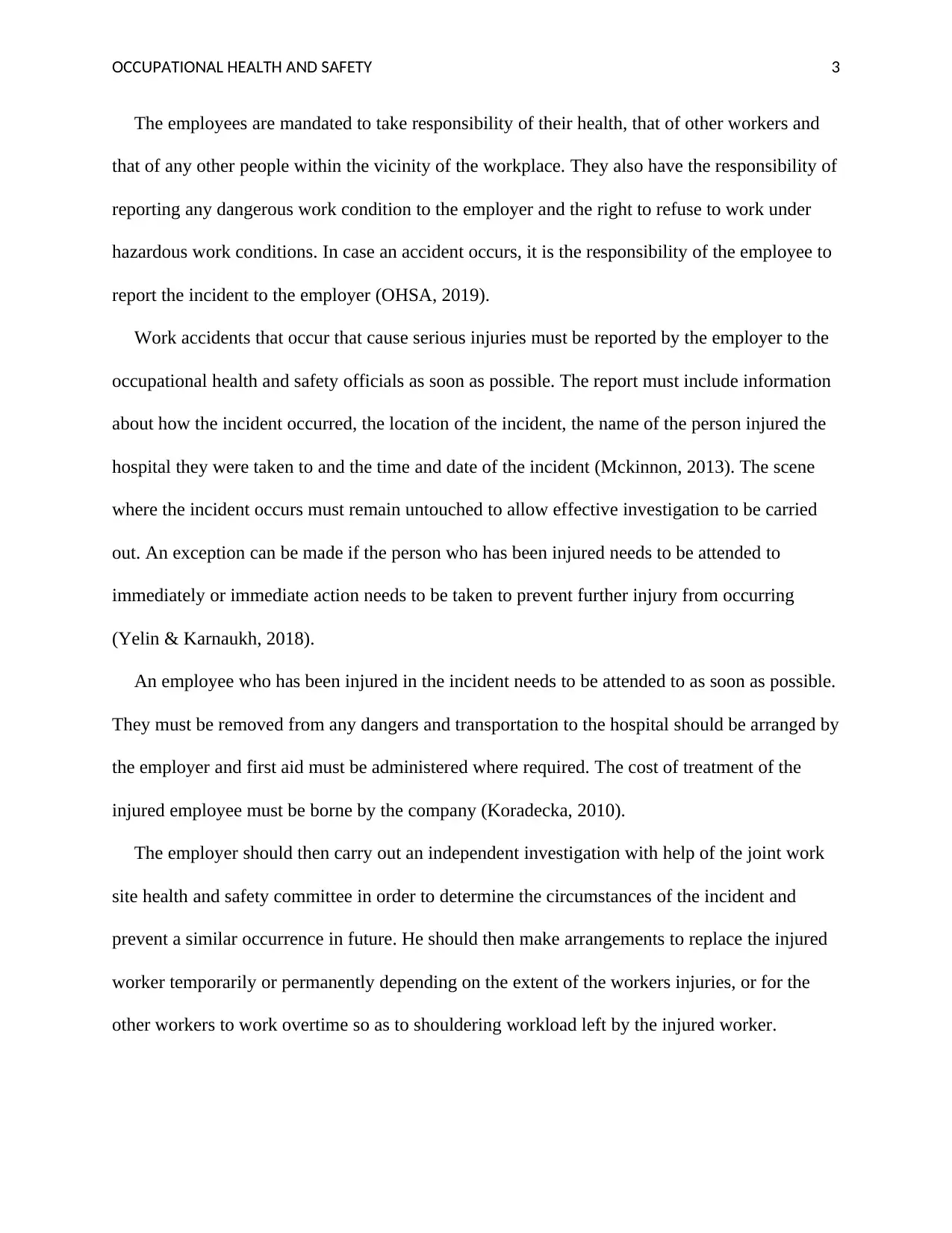
OCCUPATIONAL HEALTH AND SAFETY 3
The employees are mandated to take responsibility of their health, that of other workers and
that of any other people within the vicinity of the workplace. They also have the responsibility of
reporting any dangerous work condition to the employer and the right to refuse to work under
hazardous work conditions. In case an accident occurs, it is the responsibility of the employee to
report the incident to the employer (OHSA, 2019).
Work accidents that occur that cause serious injuries must be reported by the employer to the
occupational health and safety officials as soon as possible. The report must include information
about how the incident occurred, the location of the incident, the name of the person injured the
hospital they were taken to and the time and date of the incident (Mckinnon, 2013). The scene
where the incident occurs must remain untouched to allow effective investigation to be carried
out. An exception can be made if the person who has been injured needs to be attended to
immediately or immediate action needs to be taken to prevent further injury from occurring
(Yelin & Karnaukh, 2018).
An employee who has been injured in the incident needs to be attended to as soon as possible.
They must be removed from any dangers and transportation to the hospital should be arranged by
the employer and first aid must be administered where required. The cost of treatment of the
injured employee must be borne by the company (Koradecka, 2010).
The employer should then carry out an independent investigation with help of the joint work
site health and safety committee in order to determine the circumstances of the incident and
prevent a similar occurrence in future. He should then make arrangements to replace the injured
worker temporarily or permanently depending on the extent of the workers injuries, or for the
other workers to work overtime so as to shouldering workload left by the injured worker.
The employees are mandated to take responsibility of their health, that of other workers and
that of any other people within the vicinity of the workplace. They also have the responsibility of
reporting any dangerous work condition to the employer and the right to refuse to work under
hazardous work conditions. In case an accident occurs, it is the responsibility of the employee to
report the incident to the employer (OHSA, 2019).
Work accidents that occur that cause serious injuries must be reported by the employer to the
occupational health and safety officials as soon as possible. The report must include information
about how the incident occurred, the location of the incident, the name of the person injured the
hospital they were taken to and the time and date of the incident (Mckinnon, 2013). The scene
where the incident occurs must remain untouched to allow effective investigation to be carried
out. An exception can be made if the person who has been injured needs to be attended to
immediately or immediate action needs to be taken to prevent further injury from occurring
(Yelin & Karnaukh, 2018).
An employee who has been injured in the incident needs to be attended to as soon as possible.
They must be removed from any dangers and transportation to the hospital should be arranged by
the employer and first aid must be administered where required. The cost of treatment of the
injured employee must be borne by the company (Koradecka, 2010).
The employer should then carry out an independent investigation with help of the joint work
site health and safety committee in order to determine the circumstances of the incident and
prevent a similar occurrence in future. He should then make arrangements to replace the injured
worker temporarily or permanently depending on the extent of the workers injuries, or for the
other workers to work overtime so as to shouldering workload left by the injured worker.
⊘ This is a preview!⊘
Do you want full access?
Subscribe today to unlock all pages.

Trusted by 1+ million students worldwide
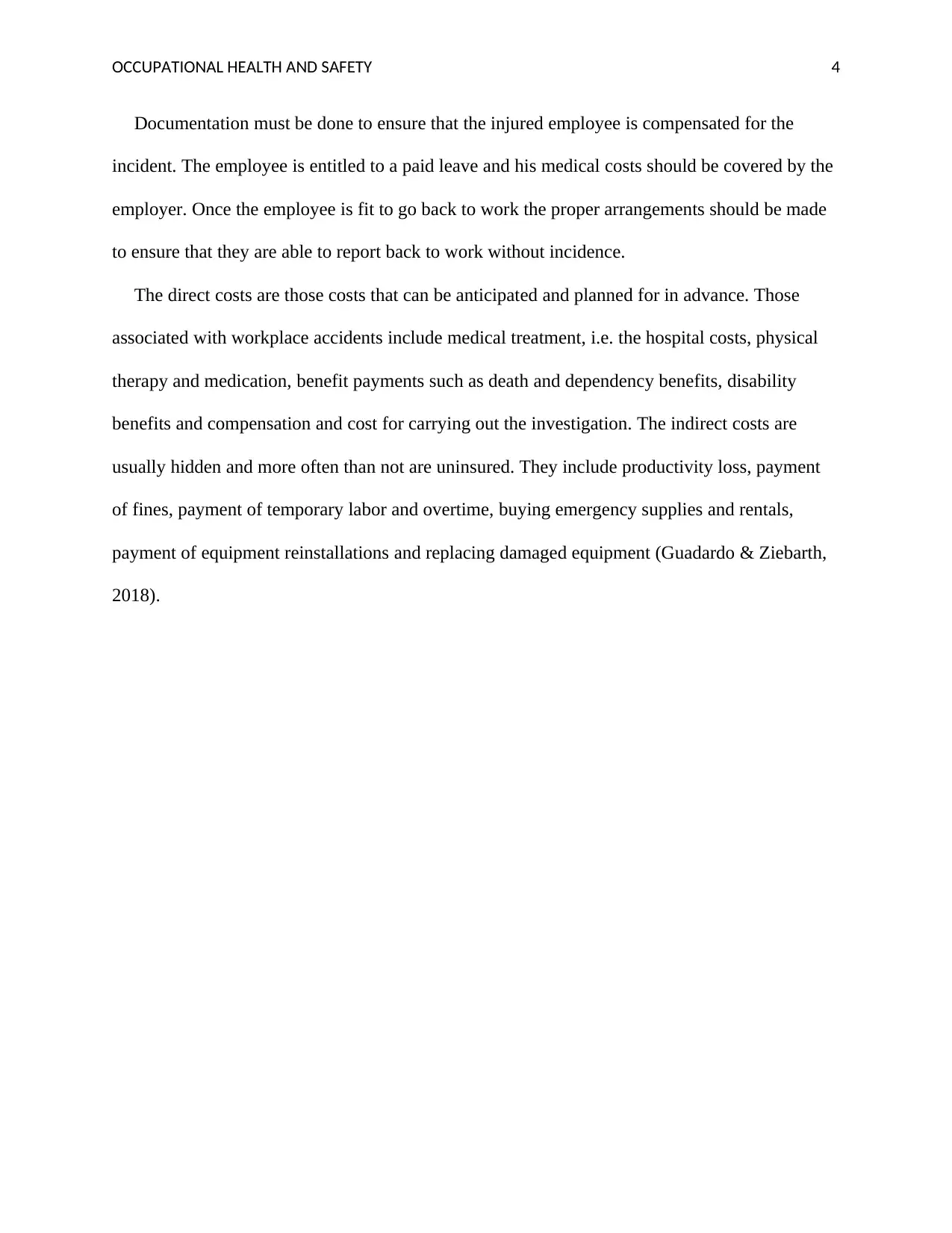
OCCUPATIONAL HEALTH AND SAFETY 4
Documentation must be done to ensure that the injured employee is compensated for the
incident. The employee is entitled to a paid leave and his medical costs should be covered by the
employer. Once the employee is fit to go back to work the proper arrangements should be made
to ensure that they are able to report back to work without incidence.
The direct costs are those costs that can be anticipated and planned for in advance. Those
associated with workplace accidents include medical treatment, i.e. the hospital costs, physical
therapy and medication, benefit payments such as death and dependency benefits, disability
benefits and compensation and cost for carrying out the investigation. The indirect costs are
usually hidden and more often than not are uninsured. They include productivity loss, payment
of fines, payment of temporary labor and overtime, buying emergency supplies and rentals,
payment of equipment reinstallations and replacing damaged equipment (Guadardo & Ziebarth,
2018).
Documentation must be done to ensure that the injured employee is compensated for the
incident. The employee is entitled to a paid leave and his medical costs should be covered by the
employer. Once the employee is fit to go back to work the proper arrangements should be made
to ensure that they are able to report back to work without incidence.
The direct costs are those costs that can be anticipated and planned for in advance. Those
associated with workplace accidents include medical treatment, i.e. the hospital costs, physical
therapy and medication, benefit payments such as death and dependency benefits, disability
benefits and compensation and cost for carrying out the investigation. The indirect costs are
usually hidden and more often than not are uninsured. They include productivity loss, payment
of fines, payment of temporary labor and overtime, buying emergency supplies and rentals,
payment of equipment reinstallations and replacing damaged equipment (Guadardo & Ziebarth,
2018).
Paraphrase This Document
Need a fresh take? Get an instant paraphrase of this document with our AI Paraphraser
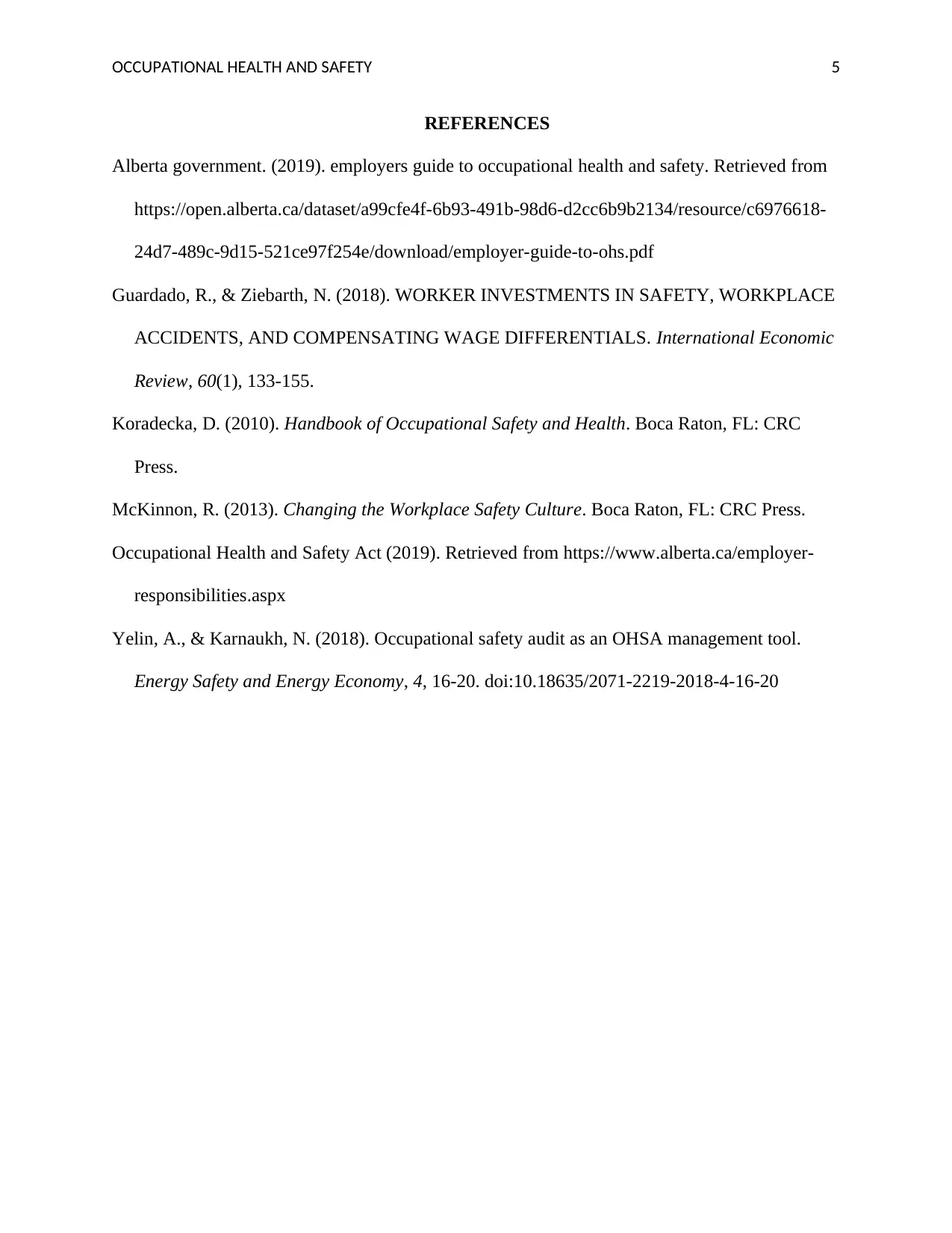
OCCUPATIONAL HEALTH AND SAFETY 5
REFERENCES
Alberta government. (2019). employers guide to occupational health and safety. Retrieved from
https://open.alberta.ca/dataset/a99cfe4f-6b93-491b-98d6-d2cc6b9b2134/resource/c6976618-
24d7-489c-9d15-521ce97f254e/download/employer-guide-to-ohs.pdf
Guardado, R., & Ziebarth, N. (2018). WORKER INVESTMENTS IN SAFETY, WORKPLACE
ACCIDENTS, AND COMPENSATING WAGE DIFFERENTIALS. International Economic
Review, 60(1), 133-155.
Koradecka, D. (2010). Handbook of Occupational Safety and Health. Boca Raton, FL: CRC
Press.
McKinnon, R. (2013). Changing the Workplace Safety Culture. Boca Raton, FL: CRC Press.
Occupational Health and Safety Act (2019). Retrieved from https://www.alberta.ca/employer-
responsibilities.aspx
Yelin, A., & Karnaukh, N. (2018). Occupational safety audit as an OHSA management tool.
Energy Safety and Energy Economy, 4, 16-20. doi:10.18635/2071-2219-2018-4-16-20
REFERENCES
Alberta government. (2019). employers guide to occupational health and safety. Retrieved from
https://open.alberta.ca/dataset/a99cfe4f-6b93-491b-98d6-d2cc6b9b2134/resource/c6976618-
24d7-489c-9d15-521ce97f254e/download/employer-guide-to-ohs.pdf
Guardado, R., & Ziebarth, N. (2018). WORKER INVESTMENTS IN SAFETY, WORKPLACE
ACCIDENTS, AND COMPENSATING WAGE DIFFERENTIALS. International Economic
Review, 60(1), 133-155.
Koradecka, D. (2010). Handbook of Occupational Safety and Health. Boca Raton, FL: CRC
Press.
McKinnon, R. (2013). Changing the Workplace Safety Culture. Boca Raton, FL: CRC Press.
Occupational Health and Safety Act (2019). Retrieved from https://www.alberta.ca/employer-
responsibilities.aspx
Yelin, A., & Karnaukh, N. (2018). Occupational safety audit as an OHSA management tool.
Energy Safety and Energy Economy, 4, 16-20. doi:10.18635/2071-2219-2018-4-16-20
1 out of 5
Related Documents
Your All-in-One AI-Powered Toolkit for Academic Success.
+13062052269
info@desklib.com
Available 24*7 on WhatsApp / Email
![[object Object]](/_next/static/media/star-bottom.7253800d.svg)
Unlock your academic potential
Copyright © 2020–2025 A2Z Services. All Rights Reserved. Developed and managed by ZUCOL.





